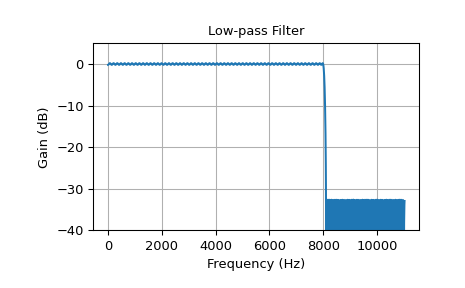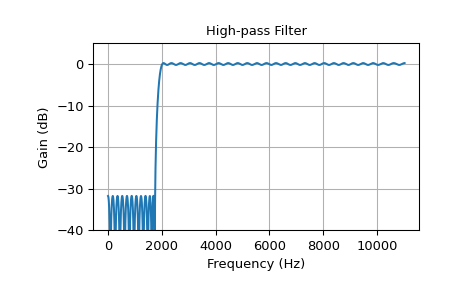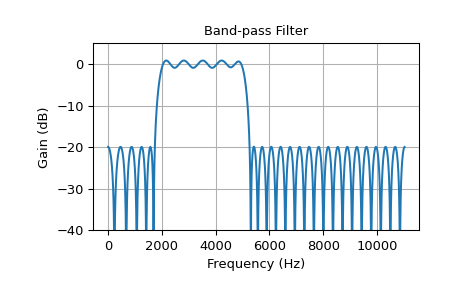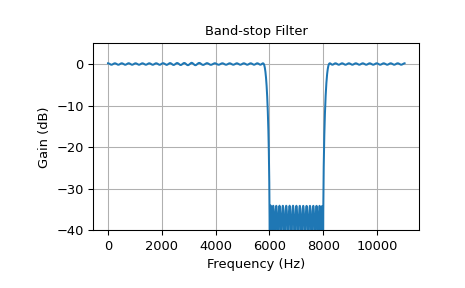remez#
- scipy.signal.remez(numtaps, bands, desired, *, weight=None, type='bandpass', maxiter=25, grid_density=16, fs=None)[源代码][源代码]#
使用Remez交换算法计算极小极大最优滤波器。
使用Remez交换算法计算有限脉冲响应(FIR)滤波器的滤波系数,该滤波器的传递函数在指定频带内最小化期望增益与实际增益之间的最大误差。
- 参数:
- numtaps整数
滤波器中所需的抽头数。抽头数是滤波器中的项数,或滤波器阶数加一。
- 乐队array_like
一个包含频带边缘的单调序列。所有元素必须为非负且小于由 fs 给出的采样频率的一半。
- 期望的array_like
一个序列,其大小为指定带宽的一半,包含每个指定带宽中所需的增益。
- 重量类似数组, 可选
每个频带区域的相对权重。weight 的长度必须是 bands 长度的一半。
- 类型{‘带通’, ‘微分器’, ‘希尔伯特’}, 可选
过滤器类型:
‘bandpass’ : 在频段内响应平坦。这是默认设置。
‘differentiator’ : 频段中的频率比例响应。
- ‘希尔伯特’具有奇对称性的滤波器,即类型 III
(对于偶数阶) 或类型 IV (对于奇数阶) 线性相位滤波器。
- maxiterint, 可选
算法的最大迭代次数。默认值为25。
- grid_densityint, 可选
网格密度。
remez中使用的密集网格的大小为(numtaps + 1) * grid_density。默认值是 16。- fsfloat, 可选
信号的采样频率。默认值为 1。
- 返回:
- 出ndarray
一个包含最优(在最小最大意义上)滤波器系数的秩为1的数组。
参考文献
[1]J. H. McClellan and T. W. Parks, “A unified approach to the design of optimum FIR linear phase digital filters”, IEEE Trans. Circuit Theory, vol. CT-20, pp. 697-701, 1973.
[2]J. H. McClellan, T. W. Parks and L. R. Rabiner, “A Computer Program for Designing Optimum FIR Linear Phase Digital Filters”, IEEE Trans. Audio Electroacoust., vol. AU-21, pp. 506-525, 1973.
示例
在这些示例中,
remez用于设计低通、高通、带通和带阻滤波器。定义每个滤波器的参数是滤波器阶数、频带边界、边界过渡宽度、每个频带的期望增益以及采样频率。我们将在所有示例中使用22050 Hz的采样频率。在每个示例中,每个频段的期望增益为0(对于阻带)或1(对于通带)。
freqz用于计算每个滤波器的频率响应,下面定义的实用函数plot_response用于绘制响应。>>> import numpy as np >>> from scipy import signal >>> import matplotlib.pyplot as plt
>>> fs = 22050 # Sample rate, Hz
>>> def plot_response(w, h, title): ... "Utility function to plot response functions" ... fig = plt.figure() ... ax = fig.add_subplot(111) ... ax.plot(w, 20*np.log10(np.abs(h))) ... ax.set_ylim(-40, 5) ... ax.grid(True) ... ax.set_xlabel('Frequency (Hz)') ... ax.set_ylabel('Gain (dB)') ... ax.set_title(title)
第一个例子是一个低通滤波器,截止频率为8 kHz。滤波器长度为325,从通带到阻带的过渡宽度为100 Hz。
>>> cutoff = 8000.0 # Desired cutoff frequency, Hz >>> trans_width = 100 # Width of transition from pass to stop, Hz >>> numtaps = 325 # Size of the FIR filter. >>> taps = signal.remez(numtaps, [0, cutoff, cutoff + trans_width, 0.5*fs], ... [1, 0], fs=fs) >>> w, h = signal.freqz(taps, [1], worN=2000, fs=fs) >>> plot_response(w, h, "Low-pass Filter") >>> plt.show()

此示例展示了一个高通滤波器:
>>> cutoff = 2000.0 # Desired cutoff frequency, Hz >>> trans_width = 250 # Width of transition from pass to stop, Hz >>> numtaps = 125 # Size of the FIR filter. >>> taps = signal.remez(numtaps, [0, cutoff - trans_width, cutoff, 0.5*fs], ... [0, 1], fs=fs) >>> w, h = signal.freqz(taps, [1], worN=2000, fs=fs) >>> plot_response(w, h, "High-pass Filter") >>> plt.show()

此示例展示了一个带通滤波器,其通带范围为2 kHz到5 kHz。过渡带宽为260 Hz,滤波器长度为63,比其他示例中的长度要小:
>>> band = [2000, 5000] # Desired pass band, Hz >>> trans_width = 260 # Width of transition from pass to stop, Hz >>> numtaps = 63 # Size of the FIR filter. >>> edges = [0, band[0] - trans_width, band[0], band[1], ... band[1] + trans_width, 0.5*fs] >>> taps = signal.remez(numtaps, edges, [0, 1, 0], fs=fs) >>> w, h = signal.freqz(taps, [1], worN=2000, fs=fs) >>> plot_response(w, h, "Band-pass Filter") >>> plt.show()

低阶数会导致更高的纹波和更不陡峭的过渡。
下一个示例展示了一个带阻滤波器。
>>> band = [6000, 8000] # Desired stop band, Hz >>> trans_width = 200 # Width of transition from pass to stop, Hz >>> numtaps = 175 # Size of the FIR filter. >>> edges = [0, band[0] - trans_width, band[0], band[1], ... band[1] + trans_width, 0.5*fs] >>> taps = signal.remez(numtaps, edges, [1, 0, 1], fs=fs) >>> w, h = signal.freqz(taps, [1], worN=2000, fs=fs) >>> plot_response(w, h, "Band-stop Filter") >>> plt.show()
